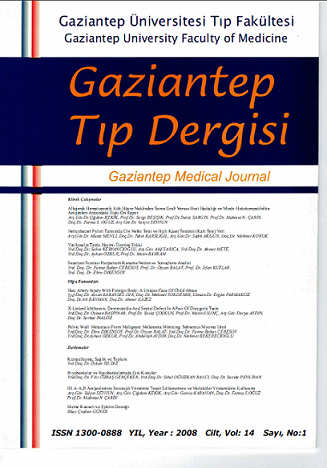The Comparison of the Urea Breath Test and the Rapid Casette Test (Card Test) in Diagnosis of Helicobacter Pylori
DOI:
https://doi.org/10.58600/eurjther.2008-14-1-1348-archKeywords:
Helicobacter pylori, Urea Breath Test (UBT), Rapid Casette TestAbstract
The purpose of this study is to determine sensitivity of the rapid H. pylori casette test in patients who were admitted to hospital with epigastric pain, and who were diagnosed with H. pylori positivity with the urea breath test, and to also analyze the role of the two tests in diagnosis. A total of 149 patients, 71 (48%) males, and 78 females (52%) with an average age of 41, who were admitted to Gaziantep University Faculty of Medicine Gasroenterology Polyclinic with epigastric pain were included in the study. The urea breath test was applied to the patients and separating serum from venous blood which was taken simultaneously, with the chromatographic immunoassay method (Cart test) (Medisera Diag. Inc., Canada) serum IgG levels were detected. The results of the urea breath test and card test were compared. A total of 91 (61%) of the 149 patients who were admitted to hospital with epigastric pain H.pylori urea breath test were positive; 128 (86%) of the patients who were examined with the rapid cassette test were detected as positivite. In 7 (8%)of the 91 patients who were found to be positive with the urea breath test, the card test was found to be negative, and in 44 (78%) of the 58 patients who were detected negative with urea breath test, positivity was detected with the card test. In diagnosis of H.pylori, a statistically significant difference was found between the urea breath test and the rapid H. pylori cassette test. When compared with the urea breath test, the specificity, sensitivity, positive predictive and negative predictive values of the rapid H.pylori card test was found to be 21.4%, 92.3%, 65.6% and 79.1 respectively. When the results were assessed considering factors such as the possibility of a late antibody response and its persistency, as well as negative effects of antibiotic and/or proton pump inhibitors, it was thought that using the chromatographic methods in seroepidemiologic studies rather than diagnosis would be more convenient.
Metrics
References
Graham DY. Albert LC, Smith JL, et al. Iatrogenic Campylobacter pylori infection is a cause of epidemic achlorhydria. Am J Gastroenterol. 1988;83:974-80.
Köksal F. Helicobacter pylori. In: Topçu AW, Söyletir G, Doğanay M, eds. İnfeksiyon Hastalıkları ve Mikrobiyolojisi. İstanbul: Nobel Tıp Kitabevleri, 2002:1643-7.
Sandıkçı MÜ, Köksal F. Helikobakter enfeksiyonları. Topçu A, Söyletir G, Doğanay M. (Eds.), Enfeksiyon Hastalıkları. Nobel Tıp Kitabevleri, İstanbul. 1996:1005-9.
Brooks GF, Janet SB, Stephen AM. Jawetz M. Melinck&Adelberg's Medical Microbiology, 21. Baskı, Appleton & Lange, Connecticut, 1995:242-3.
Fidan I, Türet S. Helicobacter Pylori Enfeksiyonunda Patogenez ve Tanı. Enfeksiyon Dergisi. 1999;13:455-460.
Ustaçelebi, Ş. (ed.): Temel ve Klinik Mikrobiyoloji, Güneş Kitapevi /Ankara, 1999:536-40.
Dunn BE, Cohen H, Biaser Mi. H. bacter pylori. Clin Mic robiol Rey. 1997;10:720-41.
Hayran M. Özdemir O. Pozitif ve Negatif Kestirim Değeri. Bilgisayar İstatistik ve Tıp, 2. Baskı Hekimler yayın Birliği/Ankara, 1996;455-60.
Nurver T, Necdet S, Ayşe K, Fikret S. Cerrahpaşa Tıp Fakültesi Aile Hekimliği anabilim dalı check-up polikliniği'ne başvuran hastalarda Helicobacter pylori sıklığı ve bunu etkileyen faktörler. Cerrahpaşa Tıp Dergisi. 2006;37:1-4.
Blaser MJ. Helicobacter pylori and the pathogenesis of gastroduodenal inflamation. J Infect Dis. 1990;161:626-33
Köksal F. Helicobacter pylori tanısında mikrobiyolojik yaklaşım. Helicobacter pylori sempozyum kitabı s:28-43. 2005.
Chey W D. Accurate diagnosis of Helicobacter pylori: 14C-Urea Breath test.Gastroenter Clin North Am. 2000;29:895- 903.
Megraud F. European Paediatric Task Force on Helicobacter pylori. Comparison of non-invasive tests to detect Helicobacter pylori infection in children and adolescents: results of a multicenter European study. J Pediatr. 2005;146(2):198-203.
Kosunen Tu, Seppala K,Sarna S, et.al. Diagnostic value of decreasing IgG,IgA and IgM antibody titres after erdication of H. pylori Lancet. 1992;339:893-5.
Patel P,Mendall MA, Khulusi S, et.al Salivar antibodies to H. pylori:screening dyspeptic patients before endoscopy. Lancet, 1994;344:511-12.
Holtmann G, Goebell H, Holtmann M, et al. Dyspepsia in healthy blood donors. Pattern of symptoms and association with Helicobacter pylori. Dig Dic Sci. 1994;39:1090-8.
Graham DY, Klein PA, Evans DJ et al. Campylobacter pylori detected non-invasively with the 13 C-urea. Lancet. 1987;1:1174-7.
Dominguez - Munoz JE, Leodolder A, Squerbruch T, et al. A citric acid solution is an optimal test drink in the 13C- urea breath test for the diagnosis of Helicobacter pylori infection. Gut. 1997;40:459-62.
Cohen H, Rose S, Lewin DN, et al. Accuracy of four commercially available serologic tests, including two officebased tests and a commercially available 13 C urea breath test, for diagnosis of Helicobacter pylori. Helicobacter. 2000;1:27-32.
Falk GW. Mide ve Duedonum Hastalıkları. Andreoli TE(ed), Cecil Essentials of Medicine. Philadelphia. 2001;5:332- 344.
Graham DY, Evans DJ, Peacock J, et al. Comparison of rapid serological tests (FlexSure HP and QuicVue) with conventional ELISA for detection of Helicobacter pylori infection. Am J Gastroenterol. 1996;91(5):942-8
Faigel DO, Magaret N, Corless C, et al. Evaluation of rapid antibody tests for the diagnosis of Helicobacter pylori infection. Am J Gastroenterol. 2000;95:72-7.
Duggan AE, Knifton A, Logan CJ, et al. Validation of two new rapid blood tests for H.pylori. Gut. 1995;37(2):85.
Lahaie RG, Ricard N. Validation of Helisal whole blood, serum and saliva tests for the non-invasive diagnosis of H.pylori infection. Gut. 1995;37(l 1):A13.
Millar Jones D, Yapp T, Thomes GAO. A new rapid whole blood tests for Helicobacter pylori antibodies could reduce diagnostic oesophago - gastroduodenoscopy (OGD) in patients with dyspepsia. Gut. 1994;35(5):1.
Moayyedi P, Carter AM, Heppell RM, et al. Validation of a rapid whole blood test for the diagnosis of Helicobacter pylori infection. Gut. 1995;36(l 1):A51.
Downloads
Published
How to Cite
Issue
Section
License
Copyright (c) 2023 European Journal of Therapeutics

This work is licensed under a Creative Commons Attribution-NonCommercial 4.0 International License.
The content of this journal is licensed under a Creative Commons Attribution-NonCommercial 4.0 International License.


















